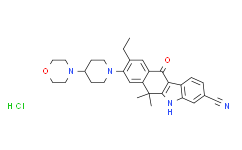| Description: |
Alectinib Hydrochloride (CH5424802 Hydrochloride) is a potent, selective, and orally available ALK inhibitor with IC50 of 1.9 nM, the dissociation constant (KD) value for ALK in an ATP-competitive manner is 2.4 nM using a competition-bind assay. |
| Target: |
IC50: 1.9 nM (ALK), 1 nM (ALKF1174L), 3.5 nM (ALKR1275Q)[1] Kd: 2.4 nM (ALK)[1] |
| In Vivo: |
In the NCI-H2228 model, once-daily oral administration of Alectinib (CH5424802) results in dose-dependent tumor growth inhibition (ED50=0.46 mg/kg) and tumor regression. Treatment of 20 mg/kg Alectinib shows rapid tumor regression (168% tumor growth inhibition; p<0.001), the tumor volume in any mouse is <30 mm3 after 11 days of treatment (at day 28), a potent antitumor effect is maintained, and tumor re-growth dpes not occur throughout the 4-week drug-free period[1]. Oral administration of Alectinib (CH5424802) at 20 mg/kg displays significant tumor regression without body weight loss in an established ALK fusion gene-positive NSCLC xenograft model in mice[2]. Alectinib at 60 mg/kg causes tumor regression against EML4-ALK-positive NCI-H2228 xenograft model and decreases the levels of phosphorylated ALK in this model. In addition, in mice at dose levels up to 60 mg/kg of Alectinib, there is no body weight loss, no significant change in peripheral blood cell count, no elevations of aspartate aminotransferase or alanine aminotransferase, and no substantial change in electrolytes. Oral administration of Alectinib at 60 mg/kg for 4 days results in significant tumor regression seen in the luminescence signal[3]. |
| In Vitro: |
Alectinib (CH5424802) prevents autophosphorylation of ALK in NCI-H2228 NSCLC cells expressing EML4-ALK, and Alectinib also results in substantial suppression of phosphorylation of STAT3 and AKT, but not of ERK1/2[1]. Alectinib (CH5424802) shows high kinase selectivity and strong anti-proliferative activity against KARPAS-299 with an IC50 value of 3 nM[2]. |
| Kinase Assay: |
The inhibitory ability against each kinase except for MEK1 and Raf-1 is evaluated by examining their ability to phosphorylate various substrate peptides in the presence of Alectinib using time-resolved fluorescence resonance energy transfer (TR-FRET) assay or fluorescence polarization (FP) assay. The inhibitory activity against MEK1 is evaluated by quantitative analysis of the phosphorylation of a substrate peptide by a recombinant ERK2 protein in the presence of Alectinib. The inhibitory activity against Raf-1 is evaluated by examining the ability of the kinases to phosphorylate MEK1 in the presence of Alectinib[1]. |
| Cell Assay: |
Cells are cultured in 96-well plates overnight and incubated with various concentrations of Alectinib for the indicated time. For spheroid cell growth inhibition assay, cells are seeded on spheroid plates, incubated overnight, and then treated with Alectinib for the indicated times. The viable cells are measured by the CellTiter-Glo Luminescent Cell Viability Assay. Caspase-3/7 assay is evaluated using the Caspase-Glo 3/7 Assay Kit[1]. |
| Animal Administration: |
Mice[1] Cell lines are grown as s.c. tumors in SCID or nude mice. Therapeutic experiments are started (day 0) when the tumor reaches ~250 or ~350 mm3. Mice are randomized to treatment groups to receive vehicle or Alectinib (oral, qd) for the indicated duration. Final concentration of vehicle is 0.02 N HCl, 10% DMSO, 10% Cremophor EL, 15% PEG400, and 15% HPCD (2-hydroxypropyl-β-cyclodextrin). The length (L) and width (W) of the tumor mass are measured, and the tumor volume (TV) is calculated as: TV=(L×W2)/2. Tumor growth inhibition is calculated using the following formula: tumor growth inhibition=[1−(T−T0)/(C−C0)]×100. The ED50 is calculated from the values of tumor growth inhibition on the final experimental day. Rats[3] Plasma and brain (cerebrum and cerebellum) samples are prepared at various time points between 4 and 168 h after a single oral administration of 14C-labeled Alectinib at 1 mg/kg to a rat. The radioactivity concentrations in plasma are determined by a liquid scintillation counter, and the radioactivity concentrations in brain are quantified using quantitative whole-body autography. |
| References: |
[1]. Sakamoto H, et al. CH5424802, a selective ALK inhibitor capable of blocking the resistant gatekeeper mutant. Cancer Cell. 2011, 19(5), 679-690.
[2]. Kinoshita K, et al. Design and synthesis of a highly selective, orally active and potent anaplastic lymphoma kinase inhibitor (CH5424802). Bioorg Med Chem. 2012, 20(3), 1271-1280.
[3]. Kodama T, et al. Antitumor activity of the selective ALK inhibitor alectinib in models of intracranial metastases. Cancer Chemother Pharmacol. 2014 Nov;74(5):1023-8. |






















